
Digital media trends Are ads the prescription for subscription fatigue?
11 minute read
19 September 2019
 Kevin Westcott United States
Kevin Westcott United States Jeff Loucks United States
Jeff Loucks United States David Ciampa United States
David Ciampa United States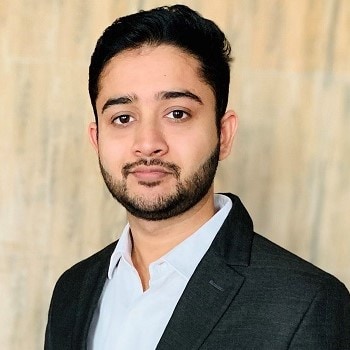 Shashank Srivastava India
Shashank Srivastava India
Consumers will trade attention for online content—creating new demand for an old model.
Consumers have added subscriptions to online entertainment alternatives swiftly in recent years. In response, many traditional content makers, such as Hollywood studios, have flipped their business models. However, the shift to digital platforms also offers benefits, such as greater efficiency and precision, that could help media and entertainment (M&E) companies reimagine how advertising can be paired with content. This is another reason why over-the-top (OTT) advertising-supported video has become so much more than just “TV on the internet.”
Learn more
View more from the Digital media trends survey, 13th edition
Read Digital media trends: Video gaming goes mainstream
Explore the Telecom, media & entertainment collection
Subscribe to receive related content from Deloitte Insights
Download the Deloitte Insights and Dow Jones app
Media and entertainment companies are placing big bets on developing new direct-to-consumer (DTC) video streaming services that are often ad-free. But Deloitte’s Digital media trends survey, 13th edition shows that they might want to reconsider the role of advertising as they build new digital offerings. Advertising has been an essential part of how content is funded and distributed, but as the industry transitions to new digital models, companies will be weighing how to optimize its use going forward.
The rising competition for consumers’ attention across M&E comes as major companies are planning and executing a transition from traditional distribution models to DTC models. Media giants are more emphatically embracing direct distribution strategies, and taking more control over how they engage with consumers. After explosive growth over the past five years, there are now more than 300 streaming video services (including various ad-free and ad-supported models) available in the United States alone.1 However, following some high-profile service launches over the next 12 to 18 months from companies such as Apple, Disney, Comcast, and WarnerMedia, the landscape is expected to morph and expand.2
Although many new services tend to focus on an ad-free subscription model, where customers commonly pay a monthly fee to access broad content libraries, an analysis of Deloitte’s Digital media trends survey, 13th edition indicates that companies may need to be more open-minded and flexible with monetization and pricing strategies.
Another factor that could challenge the growth of streaming subscriptions is that there are signs of subscription-related frustration, or “subscription fatigue.” This is particularly relevant in the current environment, in which decreasing amounts of high-profile content will be made available on broad aggregators such as Netflix and Amazon3 as compared to the past, potentially leaving consumers to subscribe to additional services to access content.
Key highlights from the survey include:
- More than half of all consumers are willing to view advertising with video programming if it reduced subscription costs.
- Younger consumers, with a presumed low tolerance for advertising, consume a higher proportion of ad-supported streaming content than the average level for younger consumers.
- Consumers who stream video are less likely to be motivated by “ad-free” models to subscribe to a new streaming service than nonvideo streaming consumers.
- Price is more important than removing ads to entice avid service subscribers (consumers with three or more subscription services) to subscribe to an additional service.
The survey highlights offer a sobering perspective amid the rush by content creators to a predominantly subscription-based future, where a high proportion of video viewing is outside of the advertising ecosystem. The points above may prompt companies to rethink how they plan to include advertising in their future service offerings.
In the age of on-demand, it might seem counterintuitive to have a buoyant view of a strategy that depends on disrupting video viewing. But many may be underestimating how canny consumers are becoming, which highlights the cognitive dissonance between the purported aversion to advertising and actual consumer behavior in practice.
To be sure, long, frequent, repetitive, and irrelevant advertising diminishes the user experience, and the growth of streaming options outside the ad ecosystem has benefitted from this. However, not all advertising models are alike. A significant number of consumers say they pay more attention to 10 second ads compared with 30 second ads,4 and a similarly significant group is more willing to trade their personal data in exchange for a better experience or reduced cost.
Up with OTT
The rising competition for space in the video streaming market has led to explosive growth in over-the-top (OTT) platforms and services—as well as content creation and availability. The number of scripted TV shows on streaming platforms, such as Netflix and Amazon, has now surpassed broadcast networks.5 The content glut is so large that even critically acclaimed TV shows with A-list movie stars struggle to break through to consumers. Amazon's original TV series Homecoming, which stars Julia Roberts and premiered in November 2018, has a rating of 7.6 on Film and TV website IMDb (owned by Amazon) drawn from 2,800 reviewers based in the United States. Whereas You, a TV series that premiered only two months earlier on Lifetime TV network before being licensed to Netflix in early 2019, does not have any high-profile actors and has a rating of 7.9 drawn from 7,000 reviewers based in the United States.6
Commercial realities of TV
Economic trade-offs between more expensive traditional video delivery and lower entry price modulated access have played a big role in shifting viewers toward DTC services. However, the increase in consumers’ frustration with the traditional video ecosystem has come at a time when pay TV subscriptions have declined while DTC account activations have increased.7
The growth of video streaming platforms has come at the cost of, and in some instances despite, the traditional TV ecosystem. Although advertising breaks have been elemental to traditional TV, no matter where they appear, they are seldom welcome. Only 8 percent of US consumers say that advertising is disruptive to a “low” degree across all devices (from TVs to desktop computers).8 In other words, for 92 percent of consumers, advertising is either moderately disruptive or highly disruptive across all platforms whenever they watch content, according to Deloitte’s Digital media trends survey, 13th edition.9 Clearly, advertising is a big annoyance to an overwhelming majority of consumers. While this may not be surprising, most consumers are pragmatic about the value exchange between advertising and content.
Let’s get one thing straight, though: Most rational consumers don’t want to watch commercials. Coworkers don’t, ordinarily, gather around the watercooler to talk about the commercials during the latest episode of a hit network show. So, how many ads is tolerable for most consumers? Given the opportunity to provide a number for the total minutes of advertising per hour that they thought would be “about right,” wouldn’t most, if not all, say zero?
Interestingly, only about 10 percent said zero.10 This shows that despite the disruptions caused by advertising, consumers are broadly comfortable with, and accept the value exchange between, advertising and content.
Eight is enough
Consumer expectations about the volume of advertising are at odds with the commercial realities of traditional TV, according to Deloitte’s Digital media trends survey, 13th edition. On balance, consumers say that about eight minutes of advertising, or an ad load (ratio of advertising minutes to total viewing minutes) of 13 percent per hour of video content, is a fair ratio, but that 16 minutes of commercials per hour is “too many” for them to consider watching. This data highlights a clear point of vulnerability for M&E companies operating in traditional TV, such as broadcast TV networks, which show up to 20 minutes of advertising per hour, implying an ad load of up to 33 percent.
While the standard volume of ads is excessive for most consumers, there were some surprises when we explored ad tolerance across generations (figure 1). Given that younger generations have grown up through the rapid growth of streaming video, some might expect them to have a lower tolerance for ads. That is not true: In fact, they are slightly more tolerant than boomer and mature generation viewers. Based on survey data, younger consumers have a higher tolerance for advertising volume per hour: Generation Z consumers, for example, feel that 8.5 minutes is fair, while 17 minutes is too much. Meanwhile, the boomer and mature generations, those presumably most accustomed to traditional TV, consider lower levels of advertising as fair and can tolerate the lowest maximum volume of ads per hour.
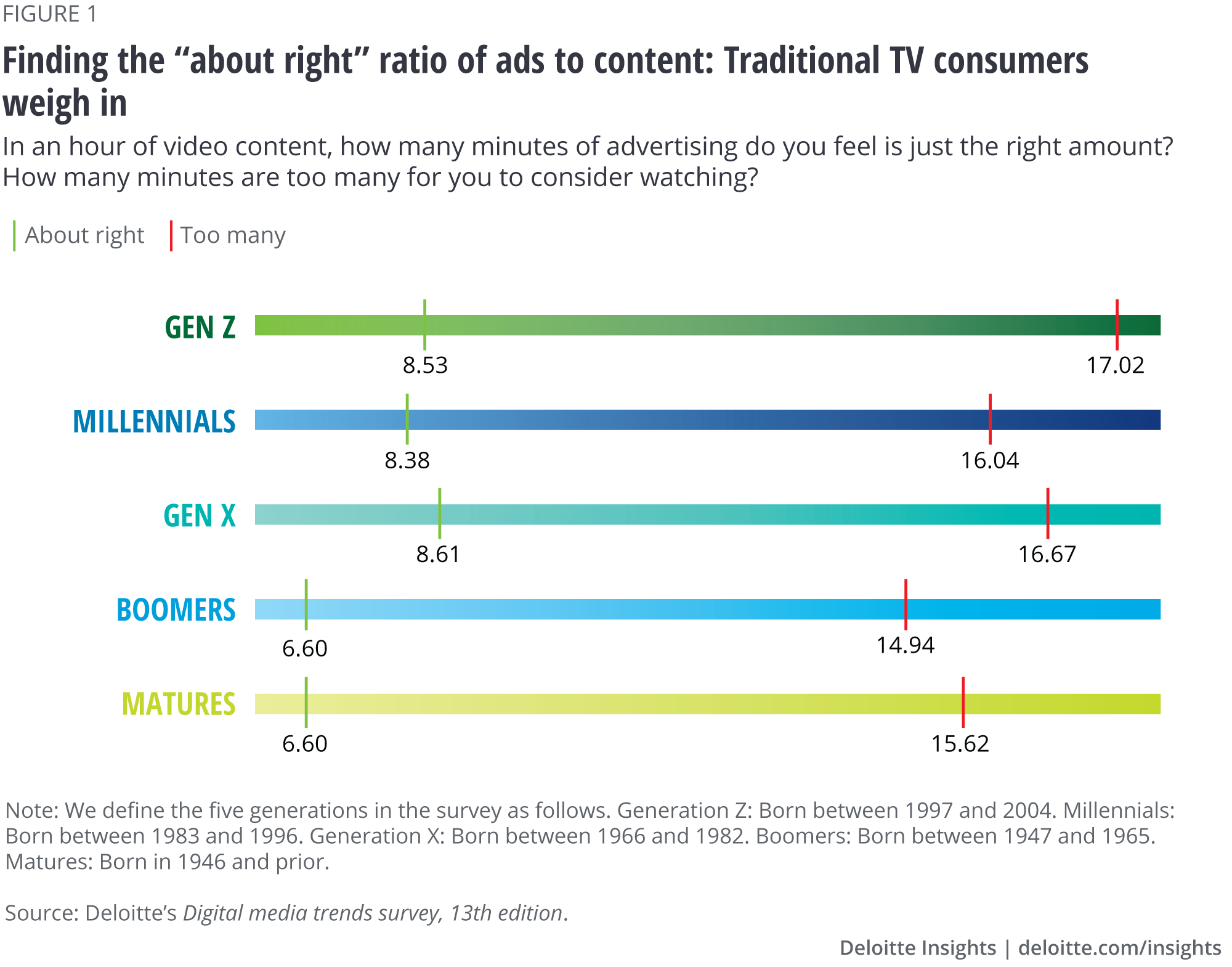
Streamers tolerate more ads
The prospects are even brighter for ad-supported services on OTT. Consumers who subscribe to a live TV streaming service, such as AT&T TV Now (formerly DirecTV Now) or Sling TV, have an even higher tolerance for advertising (figure 2). Gen Z consumers who use a live TV streaming service believe 10.6 minutes of advertising per hour is fair and 18.7 minutes per hour is the maximum.
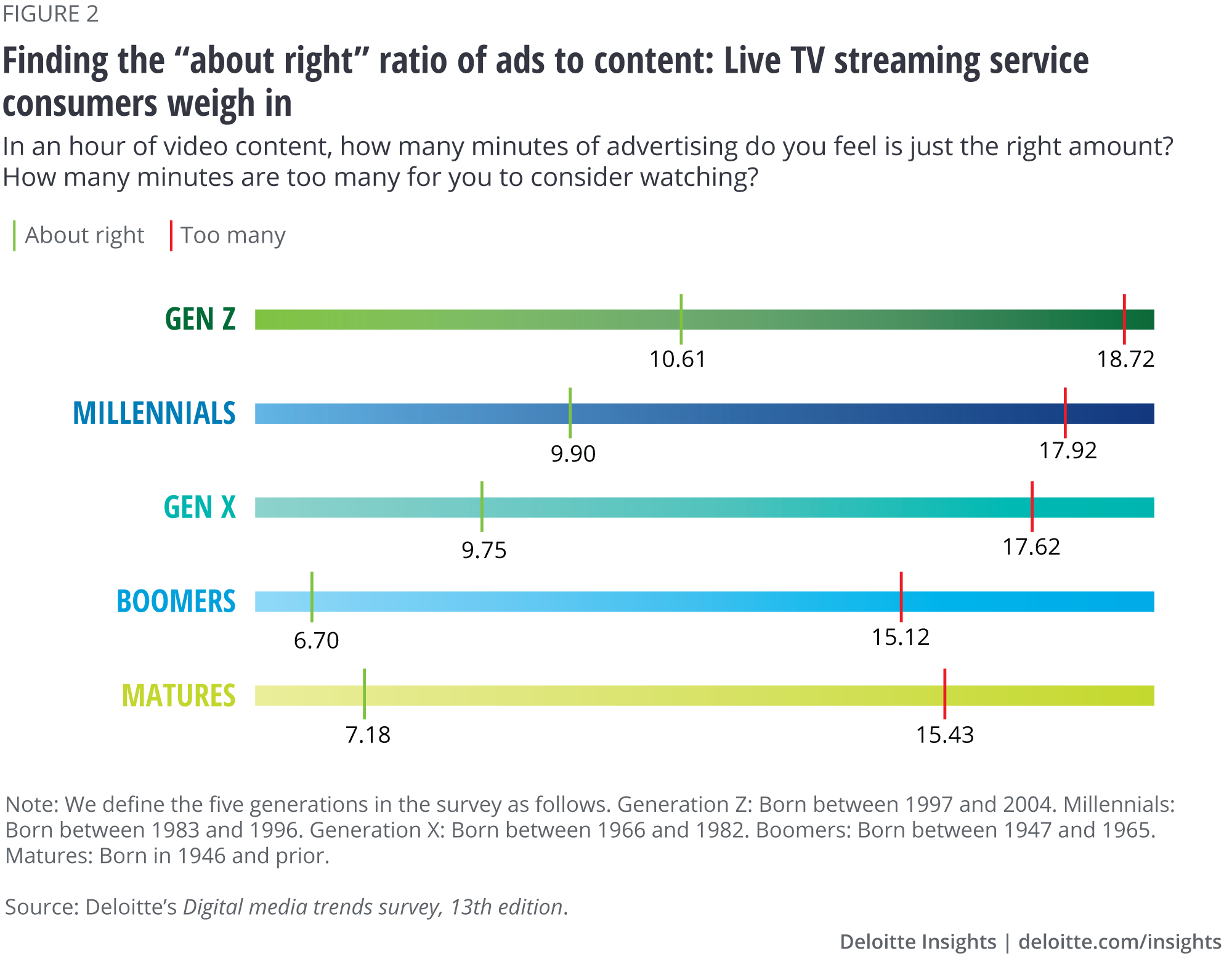
But wait. Don’t most consumers switch to nontraditional platforms to avoid advertising, a major source of friction in the traditional TV ecosystem? What does a higher tolerance for ads on streaming services tell us about consumer preferences overall?
This may be explained, in part, by the format of internet protocol (IP)-delivered TV. Currently, leading vendors such as Sling TV, AT&T TV Now (formerly DirecTV Now), YouTube TV, and Hulu TV can offer more dynamic advertising based on user profiles associated with an IP address. This allows advertisers to target consumers with more customized and personalized ads. It also lessens the friction and disruption typically associated with traditional TV ads, where big consumer brands try to gain exposure to as wide an audience as possible, but at the cost of precision and targeted addressability. According to our survey, 60 to 65 percent of Gen Z, millennial, and Gen X consumers agree that they would be more satisfied with their viewing experience if ads were more targeted and relevant.11
Further, ad tolerance results may indicate that consumers are comfortable with the value exchange between advertising and on-demand content, especially when it reduces cost. Hulu says that 70 percent of consumers choose its lower-priced advertising-supported service (currently US$5.99) compared to its ad-free subscription service (US$11.99), which shows that a majority favor watching ads over a 100 percent increase in price.12
Overloaded: What consumers do when there are too many ads
Consumers with low tolerance for advertising—those who believe the consumer average of eight minutes of advertising per hour is too much to watch—tend to watch three fewer hours of broadcast TV per week than the average consumer. This represents a 15 percent variance in broadcast TV consumption between consumers with low tolerance for ads and average viewers. But these viewers' overall watching is skewed toward streaming services as compared to average consumers (45 percent versus 40 percent).
Further, consumers with low tolerance for ads watch more hours on ad-supported streaming services than consumers who have higher tolerance for advertising on traditional TV (figure 3), especially across Gen Z, millennials, and boomers. Overall, consumers with the highest sensitivity to ads watch 4.6 hours of ad-supported streaming per week, compared to 3.9 hours for all consumers. Gen X consumers with low tolerance for advertising tend to watch more paid streaming services—an outlier against the average trend. Low tolerance Gen Z consumers increasingly tend to watch more ad-supported video content than low tolerance consumers from all the other generations.
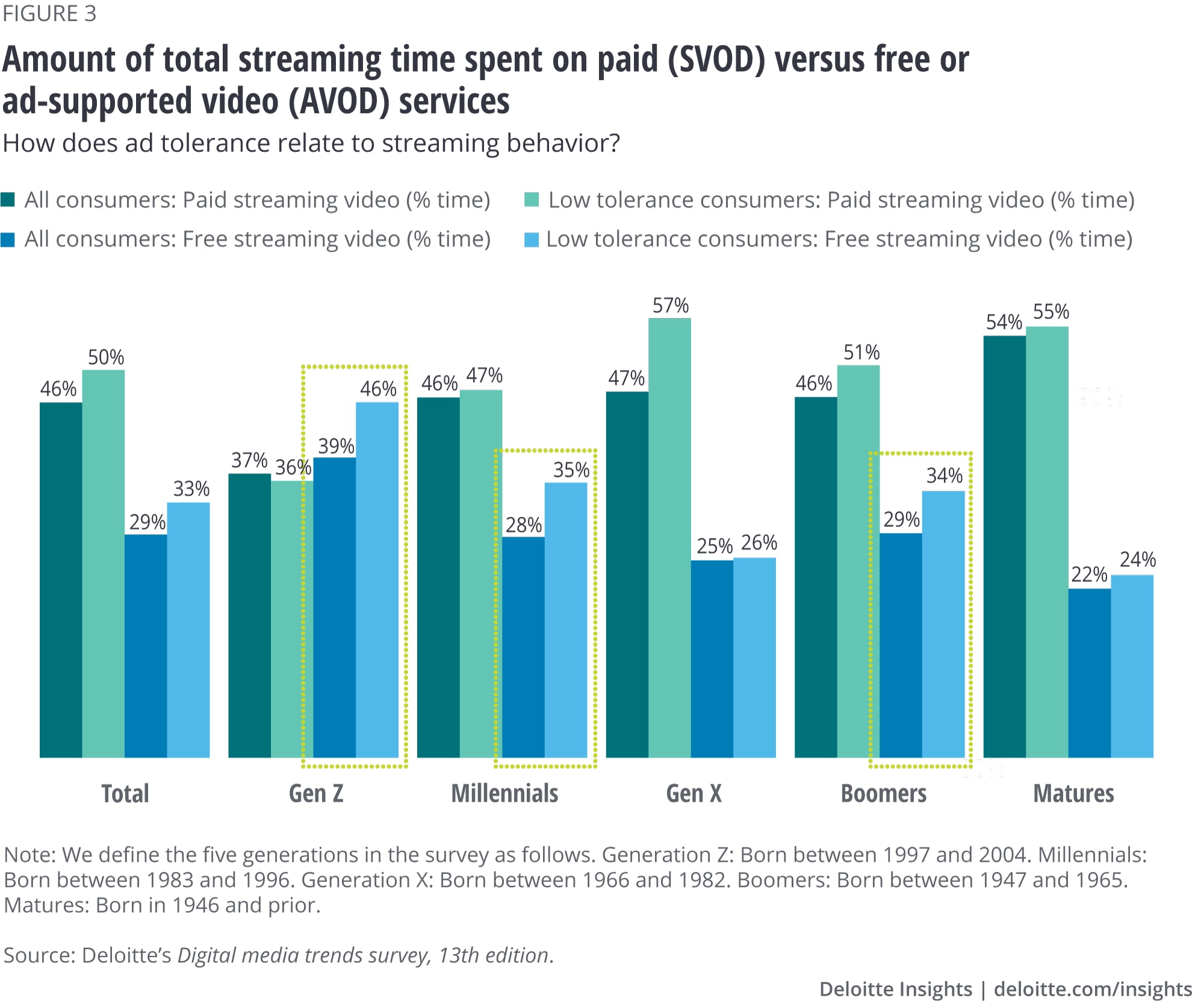
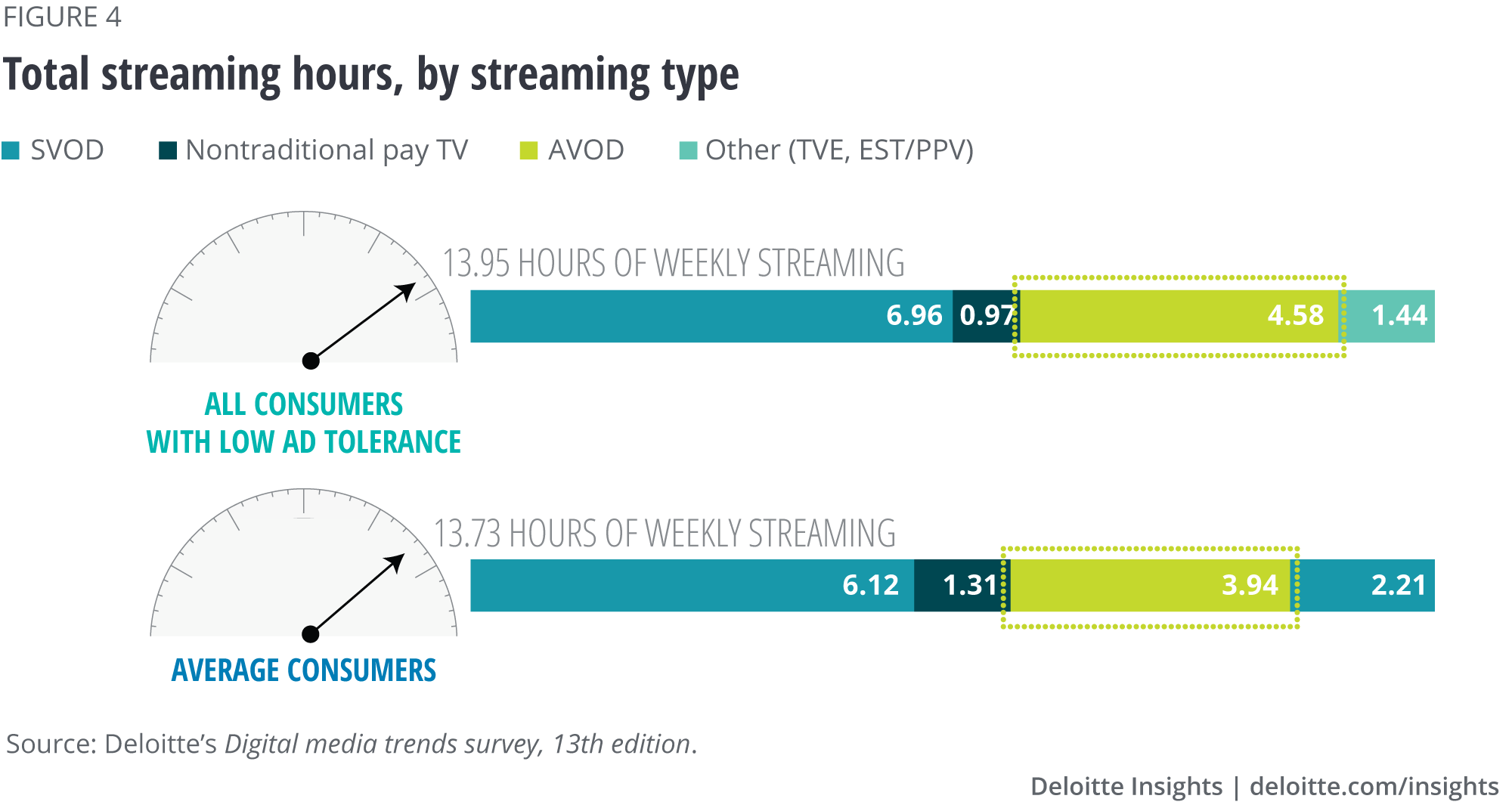
Determining the best content strategy
M&E companies may also want to assess which type of content is most suitable for ad-supported video-on-demand (AVOD) services and align their platforms accordingly (figure 5). Using only data from consumers that ranked a content type (including movies, sitcoms/dramas, news, etc.) as their favorite, we compared their “favored content types” to advertising tolerance (minutes per hour) and the proportion of streaming time spent on paid streaming services. People who prefer sitcoms/dramas are more prone to stream on subscription video-on-demand (SVOD) services as compared with those who watch movies, sports, and children’s shows. These content types are linked to consumers with below average time spend on paid streaming platforms, but a roughly average for ad tolerance compared with viewers who prefer news and sitcoms/dramas. This might build the case for ad-supported streaming video to provide a monetization opportunity for older, library movies (that is, movies that consumers tend to watch repeatedly), for which advertising is less likely to be disruptive to the experience. To give a sense of the potential audience, it is worth noting that 45 percent of consumers who view streaming video spend four hours or more per week watching movies.13

The case for ad-supported video streaming
The potential advantages of a shift to a more dynamic advertising solution and fairer exchange through ad-supported DTC services are:
- Lower ad volume/frequency. On average, a one-hour drama episode on TV consists of about 42 minutes of program run time and 18 minutes of advertising, which implies an ad load of 30 percent. On an OTT service, a TV drama episode averages five minutes of advertising, implying an ad load of less than 10 percent.14
- Dynamic/customizable. Due to the technological differences between pay TV and TV networks, content distributors have had difficulty shifting to dynamic advertising: where two consumers watching the same program can be served advertising unique to their profile and data. Because most streaming services are IP-based, it is easier to deliver and execute more addressable and contextualized advertising. Additionally, using a platform that combines streaming video with data-driven advertising can enable an efficient market for exchanging personal data for content. Among streaming video users, 40 percent say they would be willing to provide personal information online if it meant they would receive advertising relevant to interests and needs. This compares to only 20 percent of consumers who don’t pay for a streaming video service who would be willing to provide that information.
- Cheaper. As more content is shifted to content owners’ unique streaming services, subscribers must contend with managing multiple subscriptions. Here, the challenge isn’t just about managing multiple login credentials. Unlike traditional TV, where customers deal with only one service provider, if there are service fee hikes, subscribers could be hit with multiple increases. And dealing with multiple services could also make payments harder to monitor.15 Our survey found that more than half of all consumers were more likely to agree to view streaming video programming with advertising if it significantly reduced the cost of a subscription. Thirty-eight percent of consumers who don’t stream video agree that they would be willing16 to view advertising for a reduced subscription price. Among consumers who have streaming subscriptions, 70 percent of consumers with three or more subscriptions say they would view advertising for a 25 percent reduction in fees to subscribe to a new service.17
DTC isn’t a silver bullet
Despite the bullish prospects for DTC streaming video as an optimal monetization platform, it has not been a successful route for everyone. Many well-funded ventures with great content and talent have failed in the DTC market.
Over the past five years, streaming services affiliated with major studios and content creators closed down their subscription on-demand video services.18 Although these companies varied in terms of price points and content, they predominantly adopted ad-free subscription models.
Where advertising is heading
As Hollywood studios enter the DTC streaming video market, they will likely decrease the amount of content licensed to third parties to build value in their new services. This means that as more content rights revert to their original holders, there will be less content available to be licensed, which will diminish the viability of third-party OTT services. Additionally, viewing overall may become more concentrated among big-name content companies. This may present a problem for major OTTs that have sacrificed transactional video-on-demand revenue and third-party licensing fees to attract new subscribers. The potential for lost content monetization opportunities might prompt them to revisit ad-supported video, and, in addition to current models, monetize premium content, and participate in the high-value streaming behavior of consumers, instead of solely relying on a flat subscription fee model.
© 2021. See Terms of Use for more information.
More from the Telecom, media and entertainment collection
-
Is the European esports industry entering the mainstream? Article5 years ago
-
Redesigning stadiums for a better fan experience Article5 years ago
-
Connectivity of tomorrow Article6 years ago
-
Digital media trends survey Article7 years ago
-
Artificial intelligence: From expert-only to everywhere Article6 years ago
-
5G: The new network arrives Article6 years ago













